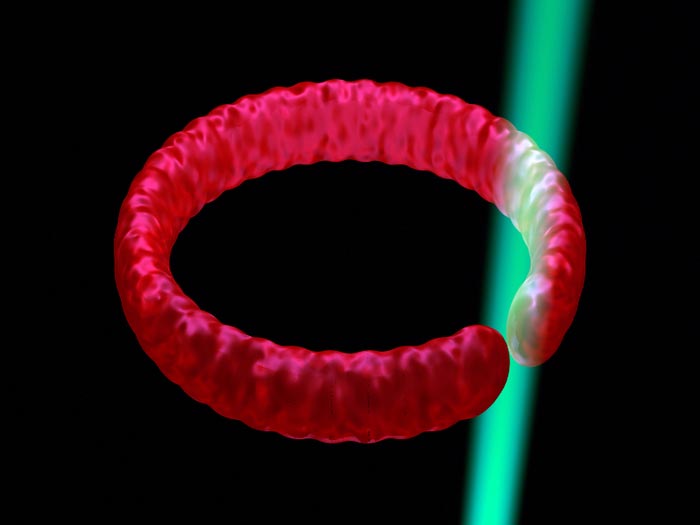Lab creates superfluid circuit using fermions to study electron behavior

By controlling rings of ultracold fermions, a Dartmouth research team has created the world’s first tunable superfluid circuit using an electron-like atom.
Image by Kevin Wright
Tunable atomic test bed allows researchers to explore the phenomena behind exotic materials.
Researchers at Dartmouth have built the world’s first superfluid circuit that uses pairs of ultracold electron-like atoms, according to a study published in Physical Review Letters.
The laboratory test bed gives physicists control over the strength of interactions between atoms, providing a new way to explore the phenomena behind exotic materials such as superconductors.
“Much of modern technology revolves around controlling the flow of electrons around circuits,” said Kevin Wright, assistant professor of physics at Dartmouth and senior researcher of the study. “By using electron-like atoms we can test theories in ways that were not possible before.”
While conductive materials such as copper are well understood, researchers do not completely understand how electrons move or can be controlled in exotic materials like topological insulators and superconductors that can be useful for building quantum computers.
The new circuit acts as a quantum emulator to explore how electrons work in real materials, offering a way to analyze the movement of electrons in a highly controllable setting.
“Electrons can do things that are far more strange and rich than anyone imagined,” said Wright. “We are learning about electrons without using electrons.”
Atomic particles are either bosons or fermions. Bosons, such as photons, tend to bunch together. Fermions, such as electrons, tend to avoid each other. While superfluid circuits using ultracold boson-like atoms already exist, the Dartmouth circuit is the first to use ultracold atoms that act as fermions.
The circuit operates on the isotope lithium-6. Although lithium-6 is a complete atom, it has properties that make it act like an individual electron. The behavior of the complete atom serves as an analogue for individual electrons.
“If we could scale the properties of lithium-6 atoms to electrons, they would be flowing without resistance even above room temperature,” said Yanping Cai, the first author of the paper who wrote the paper as a Dartmouth PhD candidate. “Studying these simple circuits might provide insights about high-temperature superconductivity.”
Laser light is used in the microscopic circuit to cool clouds of lithium atoms to temperatures near absolute zero. Once the atoms are slowed, the researchers can then hold them in place, move them around, or otherwise control them in ways that mimic how individual electrons flow around superconducting circuits.
By adjusting magnetic fields, the team can change the way the atoms interact, making the fermions attract or repel each other with varying strength, a feature that is not possible with individual electrons or other superfluid systems such as liquid helium.
According to the researchers, lasers have been used in similar techniques in other experiments, but this is the first atomic circuit that is tunable in this way. The lasers also provide the structure of the circuit and detect how the atoms are acting.
“We have crossed the threshold to build test circuits with fermionic quantum gases,” said Wright. “Designing and controlling the atom flow around a circuit with ultracold fermions in the same way that is done in an electronic device has never been accomplished before.”
The approach will allow researchers to study the formation and decay of “persistent currents” that flow indefinitely without energy input.
The ability to emulate superconducting circuits could open large experimental possibilities to test theories and to analyze materials with unique properties. The research could create opportunities for the development of new kinds of devices that use superconductors and other exotic quantum materials.
Co-authors of the research paper include Dartmouth PhD candidates Daniel Allman and Parth Sabharwal. The work was funded by the National Science Foundation. Future work will be supported by a NSF CAREER award.
Journal: Physical Review Letters
DOI: 10.1103/PhysRevLett.128.150401
Article Title: Persistent Currents in Rings of Ultracold Fermionic Atoms
Article Publication Date: 19-Mar-2022
Media Contact
David Hirsch
Dartmouth College
david.s.hirsch@dartmouth.edu
Cell: 603-646-9130
All latest news from the category: Physics and Astronomy
This area deals with the fundamental laws and building blocks of nature and how they interact, the properties and the behavior of matter, and research into space and time and their structures.
innovations-report provides in-depth reports and articles on subjects such as astrophysics, laser technologies, nuclear, quantum, particle and solid-state physics, nanotechnologies, planetary research and findings (Mars, Venus) and developments related to the Hubble Telescope.
Newest articles

Innovative 3D printed scaffolds offer new hope for bone healing
Researchers at the Institute for Bioengineering of Catalonia have developed novel 3D printed PLA-CaP scaffolds that promote blood vessel formation, ensuring better healing and regeneration of bone tissue. Bone is…

The surprising role of gut infection in Alzheimer’s disease
ASU- and Banner Alzheimer’s Institute-led study implicates link between a common virus and the disease, which travels from the gut to the brain and may be a target for antiviral…

Molecular gardening: New enzymes discovered for protein modification pruning
How deubiquitinases USP53 and USP54 cleave long polyubiquitin chains and how the former is linked to liver disease in children. Deubiquitinases (DUBs) are enzymes used by cells to trim protein…


